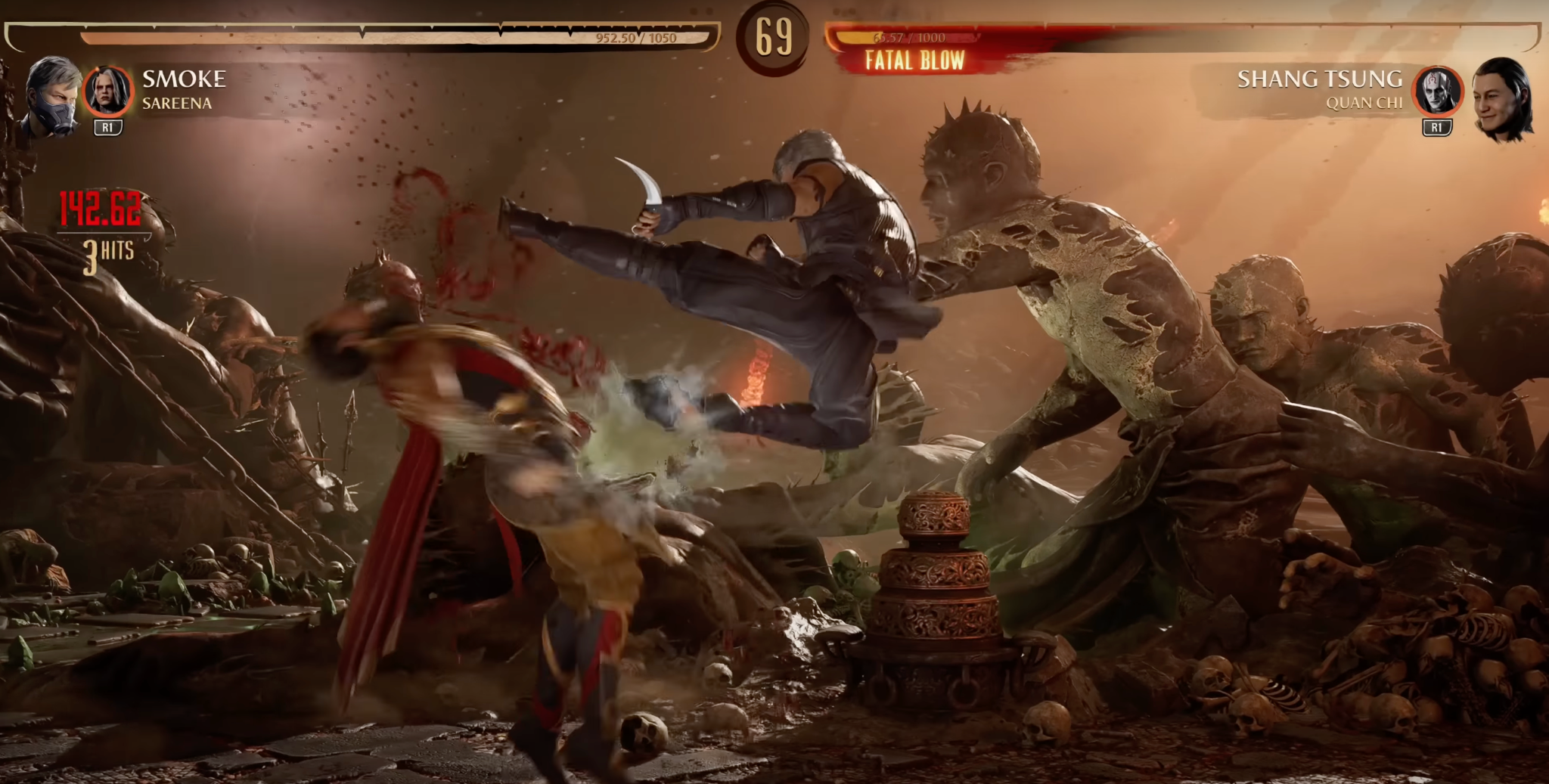
How to learn combos in
Tekken?
Want to get better at combos in Tekken 8? You’re not alone. Many players struggle with timing, routes, and execution. But don’t worry — once you understand the logic behind combos, they become way easier to learn.
Think of it like a system: every combo has a clear start, middle, and end. This section will break it all down step-by-step so that you can build your skills the smart way, not the hard way.
Let’s look at what combos are made of and how Tekken 8’s new systems change our play.
The Combo Blueprint: Launch > Filler > Screw > Ender
At the core of every combo is a simple formula:
Launcher → Filler → Screw → Ender
- Launcher: Starts the combo (e.g., df2 or hopkick)
- Filler: Adds damage (e.g., f+3, d/f+1)
- Screw: Puts the opponent into a tailspin (marked by S! in notation)
- Ender: Finishes the combo (often a hard-hitting move or wall splat)
In Tekken 8, the old “bound” system from Tekken 6 and 7 has been replaced with Screw attacks, but now the Heat System changes everything. Moves like Heat Engagers and Heat Smash add combo potential and change how damage is scaled.
Damage Scaling and Combo Choice
Not all long combos are better. Tekken uses damage scaling, which means each hit does less damage than the one before. That’s why some 7-hit combos do less damage than a strong 5-hit string.
Also, don’t ignore positioning. A lower-damage combo that carries to the wall can be much better — you get more pressure and mixups.
Understanding Character Styles
Each character has a “combo personality.”
- Mishimas (like Kazuya) use electricity for high-damage combos.
- Paul relies on big hits like Deathfist for easy power.
- Characters like Lili or Nina use trickier, movement-based strings.
Knowing your character’s combo strengths helps you practice smarter.
The 5-Step Combo Learning Method: From Scrub to Sharp
Learning combos doesn’t mean memorizing long strings all at once. The smartest players build their skills piece by piece — like stacking building blocks. This method will help you go from barely landing a launcher to pulling off full routes in real matches.
Just follow these five steps.
1. Start With Bed-and-Breakfasts (BnBs)
BnBs are your “go-to” combos. They’re not fancy, but they work. Every character has a few reliable ones that balance damage, ease, and consistency.
Where to find them:
- Practice Mode (Command List > Sample Combos)
- Community forums like Tekken Zaibatsu or Reddit
- Character guides on YouTube or Discord groups
Example – Kazuya’s BnB: PEWGF → b1,2 → S! → dash → 1,1,2
It’s not the most damaging, but it works in all situations. Focus on landing it every time.
Start with just one combo and practice it until it feels natural.
2. Break Combos Into Chunks
Long combos can feel overwhelming. Break them down.
First, just learn the launcher → filler part. Then, add the Screw attack. Finally, finish with your ending. This step-by-step method makes the timing easier to learn. Many players also suggest a potent trick:
Reddit Tip: “Practice the hardest part first.” If the screw or ender is tricky (like a dash into input), drill it solo until it’s easy.
3. Use Training Mode Tools
Training Mode in Tekken 8 is fantastic, but only if you use the tools correctly.
- Turn on Frame Data to see where you drop damage.
- Set the dummy to “Block After First Hit” to find real combos.
- Use Punish Training to simulate match situations.
- Toggle “Heat Mode” to test new combo routes.
Bonus Tip: Watch the recovery animations. If your opponent lands feet down, you probably mistimed something.
Training Mode helps you spot mistakes before they become habits.
4. Apply Combos in Real Matches
Don’t practice in a vacuum. Real matches are messy—nerves, walls, and Heat status change everything.
- Adjust your combo if you’re in Heat (some launchers change properties).
- Pre-plan two versions: with a wall and without a wall.
- If you land a side hit, some routes won’t work. Be ready.
GigaBrain Tip: Try using Heat Engagers mid-combo. They extend damage and give you a Heat Burst. Not all characters can do this, but if yours can, it’s a game-changer.
5. Build Muscle Memory With Daily Reps
Your hands need to remember the moves, not just your brain.
- Do 10 minutes of daily reps for each combo.
- Repeat each string 10 times in a row without drops.
- Say inputs out loud: “df2, f3, screw, ff2,1” — it locks the timing in your head.
Pro Tip: “If you can’t do it 10x in a row, it’s not tournament-ready.”
Stay consistent. Even five minutes a day will show results.
Avoid These Mistakes & Train Like a Pro
Even good players mess up combos — but the best know why they failed and how to fix it. This final section helps you dodge common traps and shows how pros sharpen their combos beyond the basics.
Common Pitfalls to Avoid
1. Chasing Damage Too Hard
Trying to land an 85-damage combo and dropping it is worse than landing a 70-damage one every time. Combos only help if they’re reliable. Prioritize consistency.
2. Ignoring Oki (Wake-up Pressure)
Some enders put your opponent into a bad position, even if they do less damage. A strong oki setup often leads to another combo or KO. Damage isn’t everything.
Rule of Thumb: Pick the combo that gives you position, not just numbers.
Pro Techniques to Level Up
Backturned Combos
Some characters can extend combos when the opponent lands face-down or backturned. Hwoarang’s BT stance opens more damage options — but timing is tighter.
Side-Switching Strings
In tournaments, switching sides can help escape the wall or set up positioning. Nina’s sidestep-1 cancel is one example pros use to control space mid-combo.
Heat Engager Extensions
You get bonus time and damage if your character can combo into a Heat Engager. Characters like Jin or King can route into Heat mid-combo for enormous pressure.
Pro Strategy: Practice multiple routes — with and without Heat. Adapt on the fly.
The Mental Game of Combo Practice
- How Pros Train: Top players like Knee use “no UI” training — no health bars, no input display. This train’s focus and rhythm. Others practice post-loss, analyzing why a combo dropped and fixing it immediately.
- Lab Smarter: Do your serious practice when you’re calm. Before ranked, warm up with five clean reps. After a loss, review the replay and drill the exact drop.
Combo Readiness Test: Can you land the combo…
- In lag?
- Without thinking?
- 10 times in a row?
If not, lab it again.
In Conclusion
You now know how to learn combos correctly — from the inside out. You’ve got the science, the method, and the mindset.
Start with one B&B. Break it down. Drill daily. Avoid flashy traps. Focus on what works — and works often.
Now hop into Practice Mode, pick your main, and land that combo 10 times in a row. Mastery starts today!

